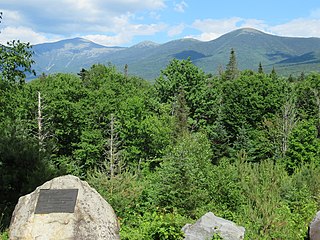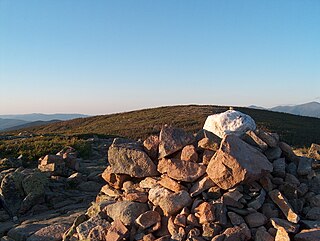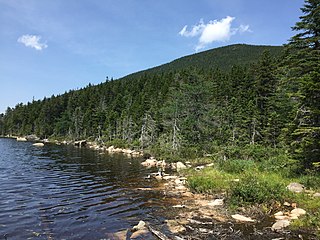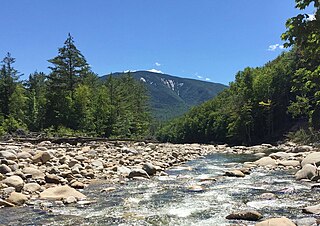| Mount Weeks | |
|---|---|
| Highest point | |
| Elevation | 1,189 m (3,901 ft) |
| Prominence | 226 m (741 ft) |
| Listing | #76 New England 100 Highest |
| Coordinates | 44°27.69′N71°22.91′W / 44.46150°N 71.38183°W |
| Geography | |
| Location | Coos County, New Hampshire |
| Parent range | Pliny Range |
| Topo map | USGS Pliny Range |
Mount Weeks, formerly Round Mountain, is a mountain located in Coos County, New Hampshire. Mt. Weeks is the northeasternmost of the Pliny Range of the White Mountains and the highest point within the city limits of Berlin, New Hampshire. Mount Weeks is flanked to the southwest by South Weeks, and faces Terrace Mountain to the northwest across Willard Notch.
Mount Weeks stands within the watershed of the upper Connecticut River, which drains into Long Island Sound in Connecticut. The southeast side of Mt. Weeks drains into Stony Brook, thence into the Upper Ammonoosuc River, a tributary of the Connecticut. The northeast side of Weeks drains into Brandy Brook, thence into the Upper Ammonoosuc. The northwest and southwest sides of Mt. Weeks drain into Garland Brook, thence into Stalbird Brook and the Israel River, another tributary of the Connecticut.
The mountain, formerly known as Round Mountain, was renamed in honor of United States Senator John W. Weeks (1860–1926) of nearby Lancaster, New Hampshire in 1961. [1] Senator Weeks sponsored the Weeks Act of 1911, under which the White Mountain National Forest was established.

Thompson and Meserve's Purchase is a township in Coös County, New Hampshire, United States. The purchase lies entirely within the White Mountain National Forest. As of the 2020 census, the population of the purchase was one.
Mount Kelsey is a mountain located in the western portion of Millsfield, New Hampshire. The western slopes of the mountain are contained within the township of Erving's Location, New Hampshire. The summit is occupied by part of the Granite Reliable Wind Farm, with road access from the Phillips Brook watershed to the south.
Mount Crescent is a mountain located in the Crescent Range of the White Mountains in Randolph, New Hampshire. It is 3,251 ft (991 m) high, and its summit is the second highest mountain summit in Randolph, after Black Crescent Mountain. Both mountains are in Randolph's Ice Gulch Town Forest. On the 1896 topographic map, Mount Crescent is shown as "Randolph Mtn." with an elevation of 3,280 ft, and Black Crescent is shown as "Mt. Crescent" with an elevation of 3,322 ft.

South Twin Mountain is a mountain located in Grafton County, New Hampshire, United States. The mountain is part of the Twin Range of the White Mountains. South Twin forms the high point of a north–south ridge, with North Twin Mountain lying approximately one mile to the north and Mount Guyot two miles (3 km) to the southeast. Galehead Mountain, a lower spur of South Twin, is to the west.
Mount Cabot is a mountain located in Coos County, in the U.S. state of New Hampshire. The mountain is the highest peak of the Pilot Range of the White Mountains. Cabot is flanked to the northeast by The Bulge, and to the south of Bunnell Notch by Terrace Mountain. Mount Cabot was named in honor of the Italian explorer Sebastian Cabot.

Mount Franklin is a mountain in Coös County, New Hampshire, United States. The mountain is named after Benjamin Franklin and is part of the Presidential Range of the White Mountains. Note that Ben Franklin was not a president. Mount Franklin is flanked to the northeast by Mount Monroe, and to the southwest by Mount Eisenhower.

Mount Field is a mountain located in Grafton County, New Hampshire. The mountain is named after Darby Field (1610–1649), who in 1642 made the first known ascent of Mount Washington. Mount Field is the highest peak of the Willey Range of the White Mountains. Mt. Field is flanked to the northwest by Mount Tom, and to the southwest by Mount Willey.

Mount Garfield is a mountain located in Grafton County, New Hampshire. The mountain is part of the White Mountains. Mt. Garfield is flanked to the east by South Twin Mountain, and to the southwest along Garfield Ridge by Mount Lafayette.

Mount Tom is a mountain located in Grafton County, New Hampshire, about 1.5 miles (2.4 km) southwest of the height of land of Crawford Notch.

Mount Tripyramid is a mountain located in Grafton County, New Hampshire. Part of the Sandwich Range of the White Mountains, it has three distinct peaks – North, Middle, and South – along its mile-long summit ridge. North, at 4,160 ft (1,270 m), is the highest. Scaur Peak and The Fool Killer are subsidiary peaks to the northwest and northeast. To the southeast, Tripyramid is flanked by The Sleepers.

Kinsman Mountain is a mountain located in Grafton County, New Hampshire. It is named after Nathan Kinsman, an early resident of Easton, New Hampshire, and is part of the Kinsman Range of the White Mountains. To the northeast, Kinsman is connected by The Cannon Balls ridge to Cannon Mountain.

Mount Guyot is a mountain located in Grafton County, New Hampshire. The mountain is named after Professor Arnold H. Guyot (1807–1884) of Princeton University, and is part of the Twin Range of the White Mountains. Mount Guyot is flanked to the northwest by South Twin Mountain, to the northeast by Mount Zealand, and to the south by Mount Bond. Guyot is on the northern boundary of the Pemigewasset Wilderness. The immediate area around the summit consists of high-altitude spruce-fir forest or krummholz.
The Bulge is a mountain located in Coos County, New Hampshire. The mountain is part of the Pilot Range of the White Mountains. The Bulge is flanked to the northeast by The Horn, and to the southwest by Mount Cabot.

Mount Nancy, formerly Mount Amorisgelu, is a mountain located in Grafton County, New Hampshire, on the eastern boundary of the Pemigewasset Wilderness of the White Mountains. The mountain is the highest point and namesake of the Nancy Range. Mt. Nancy is flanked to the northeast by Mount Bemis, to the southwest by Mount Anderson, and to the southeast by Duck Pond Mountain. Although Mount Nancy is officially trailless, a visible path climbs to the summit from Norcross Pond. With a summit elevation of 3,926 feet (1,197 m), it is one of the New England Hundred Highest peaks.

The Horn is a mountain located in Coos County, New Hampshire. The mountain is part of the Pilot Range of the White Mountains. The Horn is flanked to the southwest by the Bulge.
South Weeks, or Mount Weeks-South Peak, is a mountain located in Coos County, New Hampshire, United States, within the western part of the city limits of Berlin. The mountain is named for US Senator John W. Weeks (1860–1926) of nearby Lancaster, New Hampshire, the sponsor of the Weeks Act of 1911, under which the White Mountain National Forest was established. South Weeks is part of the Pliny Range of the White Mountains. South Weeks is flanked to the northeast by Mount Weeks, and to the southwest by Mount Waumbek.

Nubble Peak, also known as The Peak Above The Nubble, is a mountain located in Grafton County, New Hampshire. The mountain is part of the Twin Range of the White Mountains. A rock outcrop on its northwestern ridge is known as The Nubble, but topographic maps identify the formation as Haystack Mountain. Nubble Peak is flanked to the south by North Twin Mountain. The mountain is officially trailless and is one of New England's hundred highest summits.

Scar Ridge, also known as Scar Ridge , is a mountain located in Grafton County, New Hampshire. It is part of the White Mountains. It is officially trailless and several different routes are possible. Scar Ridge is flanked to the west by Loon Mountain, to the northwest by Black Mountain, and to the east by Mount Osceola.

The Cannon Balls is a mountain ridge located in Grafton County, New Hampshire. It is part of the Kinsman Range of the White Mountains. The ridge has three peaks with elevations of, from west to east, 3,693, 3,660, and 3,769 feet. The ridge takes its name from adjacent Cannon Mountain, on which a series of boulders, when viewed from the foot of the mountain, resemble an antique artillery cannon. The Cannon Balls are flanked to the northeast by Cannon Mountain, and to the southwest by Kinsman Mountain.

North Moat Mountain is a mountain located in Carroll County, New Hampshire. North Moat is flanked to the south by Middle Moat Mountain, and to the west by Big Attitash Mountain.